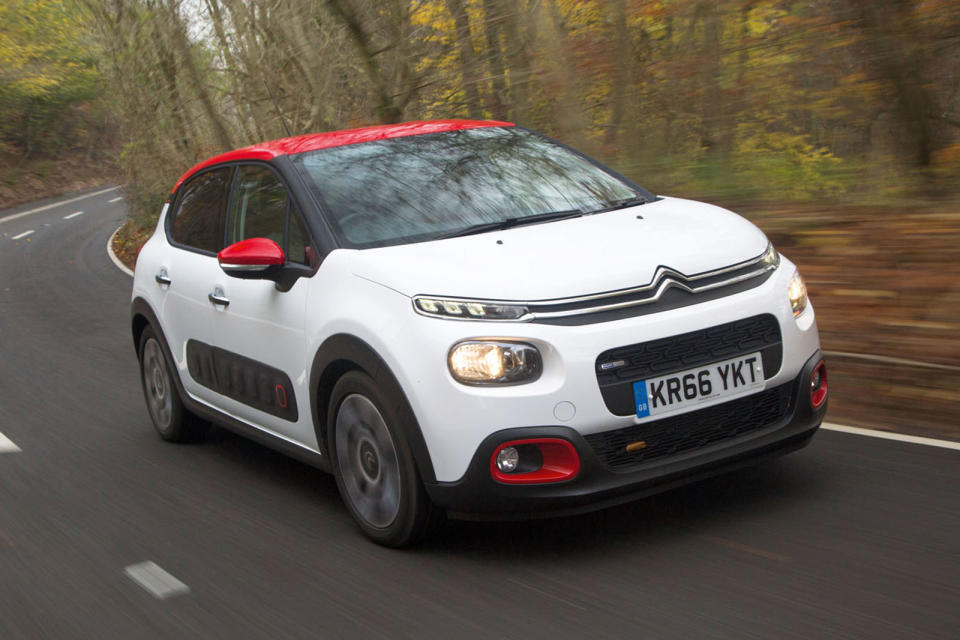Citroen C3

Compact, practical and affordable cars such as the Citroen C3 have become the cornerstone of Citroën’s business in the UK.
Its previous homage to a Parisian brand of style and glamour has been assimilated by DS, while saloons and SUVs are left to PSA Group sister firm Peugeot.
MPVs now dominate the more expensive end of Citroën’s line-up, with the Citroen C3 Picasso and Citroen C4 Cactus somewhere in the middle and the Citroen C1 propping things up at the bottom. And if the hole that leaves for the C3 is a fairly unmistakable one, then so too is the pressure on it to generate a large share of sales volume.
In the past, Citroën has succeeded by making its supermini conspicuously spacious and, because the DS 3 has become the desirable three-door variant by substitution, doggedly innocuous to look at.
The approach has resulted in 3.6 million European sales since 2002. That’s behind the Ford Fiesta, Vauxhall Corsa and Volkswagen Polo, of course, but healthy enough nonetheless.
Which makes the styling direction of this new model all the more interesting. Its predecessor looked rather like the forgettable car it replaced; the follow-up, while closely related underneath, is outwardly quite different.
Not only does it enlarge the C1’s cutesy front end but it also adopts the C4 Cactus’s Airbump flanks. Throw in two-tone paint and it’s readily apparent that Citroën is actively seeking a more style-conscious sort of customer.
No matter what you make of the C3’s new appearance, this approach is to be encouraged. Fun, affordable small models are at the cornerstone of our enthusiasm for the car as a means of transport.
Citroën has apparently followed the same progressive line of thinking underneath, eschewing the Fiesta/Mini brand of knife-edge handling for something softer and kinder from a revised chassis.
There’s considerably more technology aboard, too, and the inclusion of a social media-friendly dash cam probably reveals most of what you need to know about the C3’s market placement.
So, is it daringly different or a tarted-up reheat?
Citroen C3 design & styling
New levels of comfort and personality are the promises made by Citroën when it talks of the C3’s ‘renewal’.
This latest model receives a glut of signature features designed to lift it above the supermini morass.
The new nose, while recognisable, takes the C3 in a radically different direction from that of the old car. By joining the model at the hip with the smaller C1, Citroën has, in effect, announced a bolder design language for its small cars, one characterised by the Airbumps that were such a key feature of the C4 Cactus.
Considered alongside wheel arch extensions and a floating roof (or one alternatively coloured, at any rate), that language borrows liberally from a design lexicon normally associated with SUVs.
This ensures that the C3 has a notably different look from that of, say, a Fiesta or a Polo, no matter whether you think the result is a success or not.
It’s worth pointing out, too, that the look is very much dependent on trim level: the entry-level car, shorn of most of the features mentioned, is demonstratively more humble than the range-topper.
Underneath the much-altered body is essentially the same chassis and platform as before. Citroën describes its PF1 platform as ‘proven’, which is a nice way of saying that it’s been around for nearly 15 years.
There has been some mild fettling here, notably the inclusion of a crossbar under the seats to improve safety in the event of a side impact, but it is not substantially different. Nor is the suspension, consisting of front MacPherson struts and a rear twist beam, although Citroën has reportedly revised the spring and damper rates with the intent of offering a more compliant ride than that of the previous model.
The engine line-up is studiously on-brand, too: a 1.2-litre three-cylinder petrol unit in a choice of three outputs and a 1.6-litre four-cylinder diesel in two different guises.
Even in the C3’s lustiest format, the 1.2 Puretech 110 on test here, Citroën claims 61.4mpg combined fuel economy and CO2 emissions of 103g/km; for the lower-powered diesel, those figures are 80.7mpg and 92g/km.
That’s all very worthy, but the firm’s marketing noise is reserved for the debut of ConnectedCAM Citroën, a wide-angle video camera sited behind the rear-view mirror, from where it records the view ahead.
Ostensibly this is for automatically generated evidence in a collision, but it is the capacity to take pictures and record up to 20 seconds of video at will, and then instantly upload them to social media, that makes for the system’s true selling point.
]]>

 Yahoo Autos
Yahoo Autos 